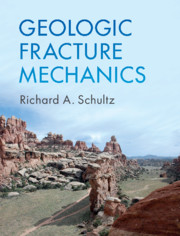Book contents
- Geologic Fracture Mechanics
- Geologic Fracture Mechanics
- Copyright page
- Dedication
- Contents
- Preface
- Acknowledgements
- 1 Introduction to Geologic Structural Discontinuities
- 2 Elastic Rock Rheology and Stress Concentration
- 3 Stress, Mohr Circles, and Deformation at Peak Strength
- 4 Cracks and Anticracks
- 5 Discontinuity Patterns and Their Interpretation
- 6 Faults
- 7 Deformation Bands
- 8 Fracture Mechanics: A Tour of Basic Principles
- 9 Beyond Linear Elastic Fracture Mechanics
- Glossary
- References
- Index
- Answers to Selected Exercises
4 - Cracks and Anticracks
Published online by Cambridge University Press: 03 August 2019
- Geologic Fracture Mechanics
- Geologic Fracture Mechanics
- Copyright page
- Dedication
- Contents
- Preface
- Acknowledgements
- 1 Introduction to Geologic Structural Discontinuities
- 2 Elastic Rock Rheology and Stress Concentration
- 3 Stress, Mohr Circles, and Deformation at Peak Strength
- 4 Cracks and Anticracks
- 5 Discontinuity Patterns and Their Interpretation
- 6 Faults
- 7 Deformation Bands
- 8 Fracture Mechanics: A Tour of Basic Principles
- 9 Beyond Linear Elastic Fracture Mechanics
- Glossary
- References
- Index
- Answers to Selected Exercises
Summary
This chapter is devoted to geologic structural discontinuities that accommodate displacements perpendicular to their surfaces, including opening-mode fractures such as cracks, joints, veins, and dikes and closing-mode structures referred to as anticracks (Table 4.1). Opening-mode structures (mode-I, Fig. 1.16) are one of the most common types of geologic structural discontinuity. Cracks are defined as sharp planar to curviplanar surfaces of opening-mode displacement discontinuity (Table 1.1). During the process of crack growth, crack walls first were created, then were moved apart normal to the fracture trace to provide a slot-like opening in the rock. Frequently the crack is filled by mineral precipitates from hydrothermal solutions, such as quartz or calcite (producing veins), crystallized magma (producing igneous dikes and sills), or even petroleum or natural gas. Near the Earth’s surface cracks or joints are often found gaping without any infilling solids (Fig. 4.1); these produce the fracture permeability necessary for efficient transport of groundwater, natural gas, and other fluids. Cracks form interesting and aesthetically pleasing patterns; these joint sets and echelon arrays contain information on the growth history of the cracks and, in turn, the brittle deformation of the host strata. Joint patterns can also provide clues to the geomorphologic and tectonic development of a region. In rock engineering, joints and other types of fractures divide an outcrop into an assemblage called a rock mass (e.g., Hoek and Brown, 1980; Chapter 3).
- Type
- Chapter
- Information
- Geologic Fracture Mechanics , pp. 143 - 169Publisher: Cambridge University PressPrint publication year: 2019



